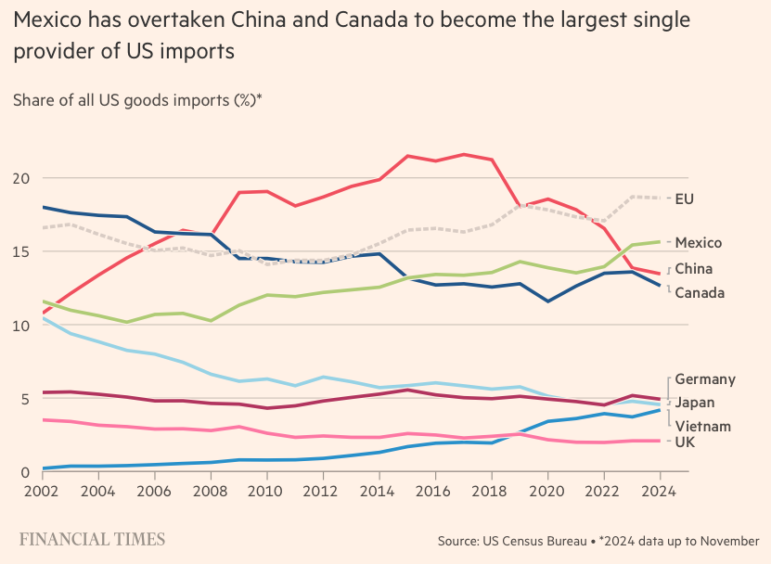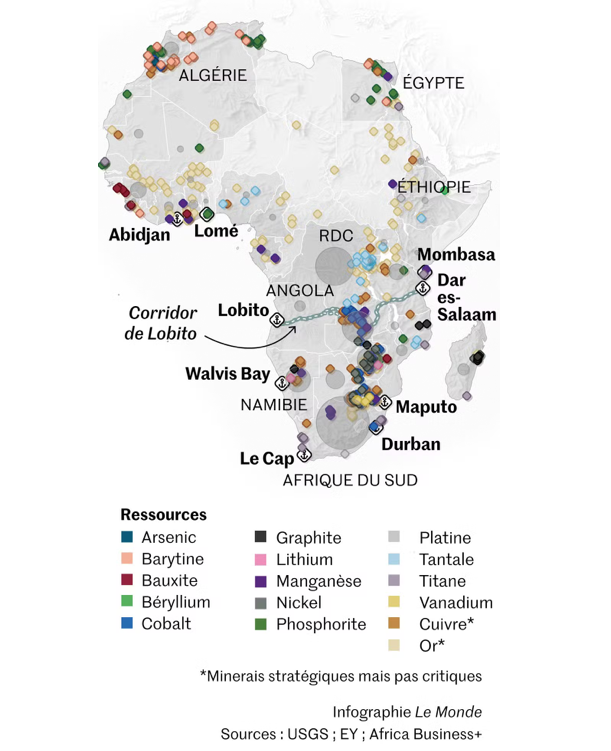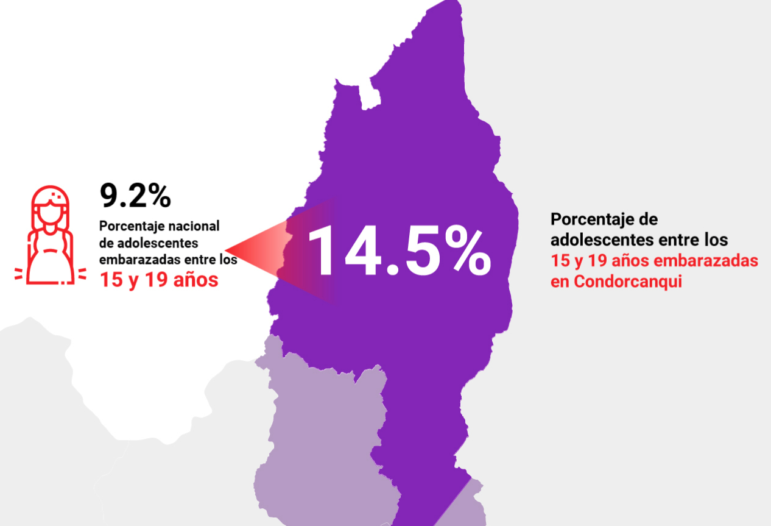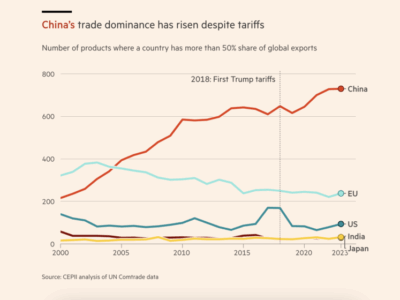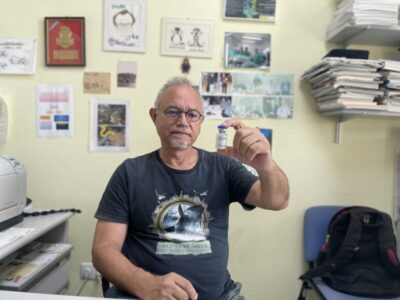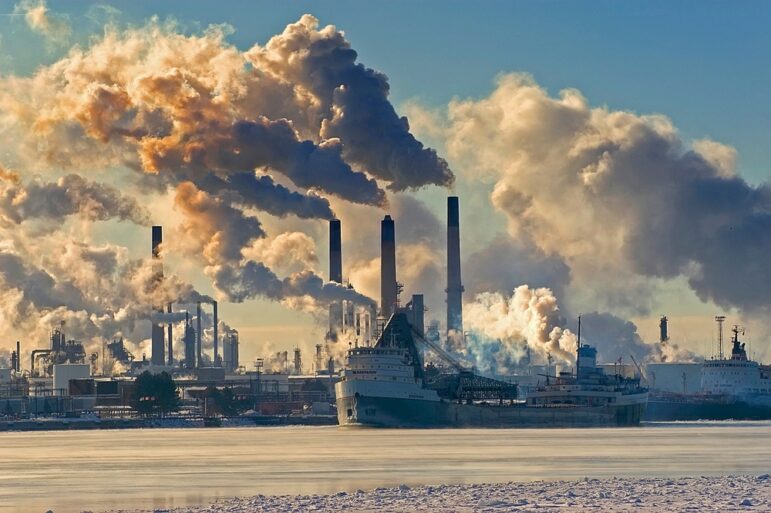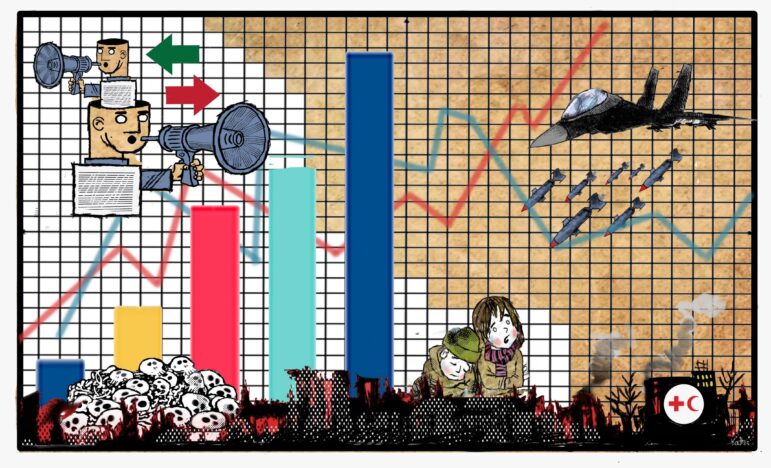
There has been no shortage of news since our last column, giving data teams a wide variety of topics to explore. Aviation accidents and the opening salvos of President Donald Trump’s planned trade warfare made headlines globally. Meanwhile, in Gaza, the next phases of the ceasefire in the conflict between Israel and Hamas, as well as the return of Palestinians to the devastated areas, have been widely covered. This edition of our Top 10 in Data Journalism, which considered stories between January 27 and February 14, also highlights an analysis of the ideological positions of German political parties; a cross-border investigation into the shadow fleet transporting sanctioned Russian oil; an analysis of the homes that survived the Los Angeles fires; and a special on the security of four-digit passwords.
Returning to Gaza, in Maps
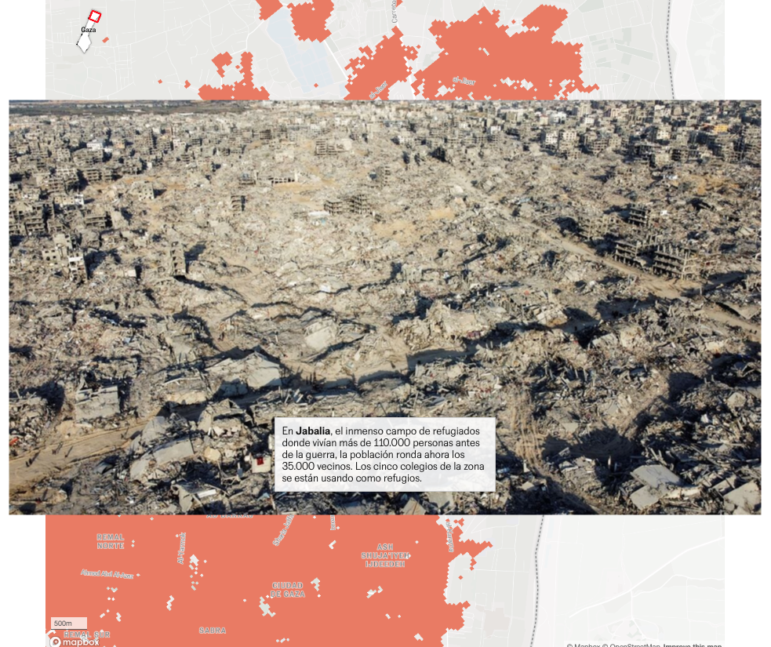
In Jabalia, an immense Gaza refugee camp where more than 110,000 people lived before the war, the population is now around 35,000 residents. The five schools in the area are being used as shelters
Image: Screenshot, El País
In recent weeks, we have seen images of thousands of Palestinians on foot returning to their homes in the Gaza Strip. The movement is part of the first phase of the ceasefire in the conflict between Israel and Hamas, which is expected to last about six weeks and includes the withdrawal of Israeli troops from populated areas of Gaza and the return of displaced Palestinians to their places of origin. In this visual special report, El País showed how the demographics of the area changed after the Israeli invasion and how they are expected to change again with the return of Palestinians. It included maps of the routes and aerial images of the pilgrimage, as well as satellite images of the places to which the refugees are returning, which highlight the unprecedented destruction. According to the report, before the start of the war more than half of the territory’s population lived in its northern regions — around 1.1 million people. To escape the war, it is estimated that more than 650,000 of these people fled south and now, according to UN estimates, more than 200,000 Gazans are expected to return.
Trump’s Trade War
US President Donald Trump had been back in office only a few days before issuing trade policy threats that sparked international upheaval. Among them were a barrage of 25% tariffs on many imports from Canada and Mexico, an additional 10% levy on China, and a 25% tariff rate on aluminum and steel imports — purportedly to counter threats from migration and fentanyl shipments into the US. Canada and Mexico secured a temporary reprieve, but Trump’s trade war plans threaten to disrupt many industries and markets, including in the US. (Trump also had to backtrack on his plan for expanding tariffs to include small packages from China, after it became clear it would be too disruptive.) In this piece, the Financial Times provided an analysis of the impact of a trade war on North America. It presented data and graphs on the percentage of all US imports of goods in the three countries and other key nations; an interactive on what goods the US imports from Mexico, China, and Canada; and a look at which industries would be most affected by the new tariffs. According to the FT, car manufacturers, food producers, and construction would be the worst hit — and consumers across Canada, Mexico, and the US would suffer.
Aircraft Collision Over the Potomac River

The New York Times recreated the 3D cockpit view from the US Army helicopter in the moments leading up to its collision with American Airlines flight 5342. Image: Screenshot, The New York Times
On the night of January 29, an American Airlines passenger jet and a US Army helicopter collided in midair near National Airport outside Washington, DC, and crashed into the Potomac River. All 67 people aboard both aircraft were killed. To understand what happened, The New York Times created a 3D model recreating the helicopter pilots’ field of vision and simulating the final minutes before the crash. The newspaper relied on information from publicly available audio recordings, flight path data, and video footage. The cause is still unclear, but the Times raises three questions that summarize the uncertainty about what the pilots saw: whether the helicopter’s altitude affected visibility, whether another aircraft could have confused the pilots, and whether night-vision goggles could have helped or hindered the pilots’ visibility. Also worth checking out is this visual investigation from the newspaper, which includes video of the crash and excerpts from a recording of communications between the helicopter pilot and air traffic control at the airport.
Deadly Bird Strikes
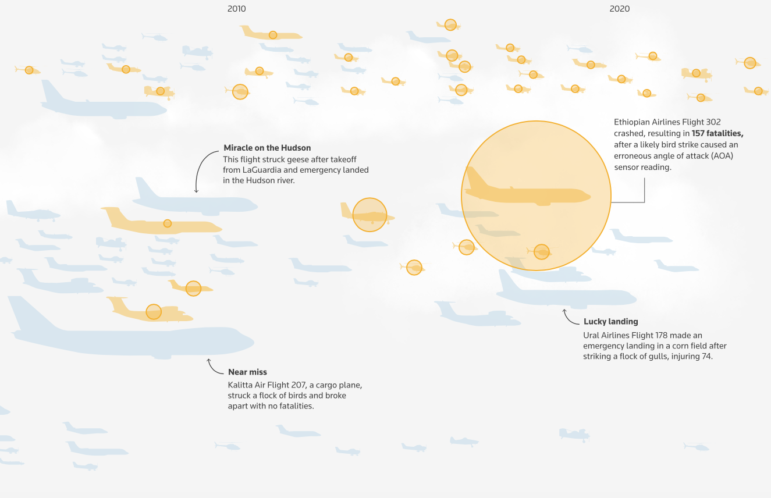
Reuters tracked major bird strikes of aircraft over the decades since 1953, and documented those that damaged the plane (blue) and led to fatalities (yellow). Image: Screenshot, Reuters
In December of last year, another plane crash killed 179 of 181 passengers when a Jeju Air jet overshot the runway and crashed into a retaining wall at Muan International Airport in South Korea. A month after the crash, a preliminary report revealed that blood and feathers belonging to a species of Siberian duck were found in both engines, which could provide evidence that a bird strike had occurred — though the incident remains under investigation. In this visual investigation, Reuters looked at bird strikes — a “serious challenge for aviation.” The outlet found that between 2016 and 2021, there were more than 270,000 reports of wildlife strikes with aircraft, but only 3% caused any damage. While serious incidents are rare, they are often fatal. The team used data from the International Civil Aviation Organization (ICAO) and Avisure, an international aviation risk consultancy based in Australia, to show in a series of illustrations the collisions that resulted in human fatalities and/or completely destroyed aircraft since 1953. The team also looked into the types of birds common around Muan Airport, where the December 2024 strike occurred; the most common bird species involved in accidents worldwide; and noted some of the more unusual animals involved in incidents — such as a giraffe, an alligator, and even turtles.
German Elections: What Voters and Parties Want
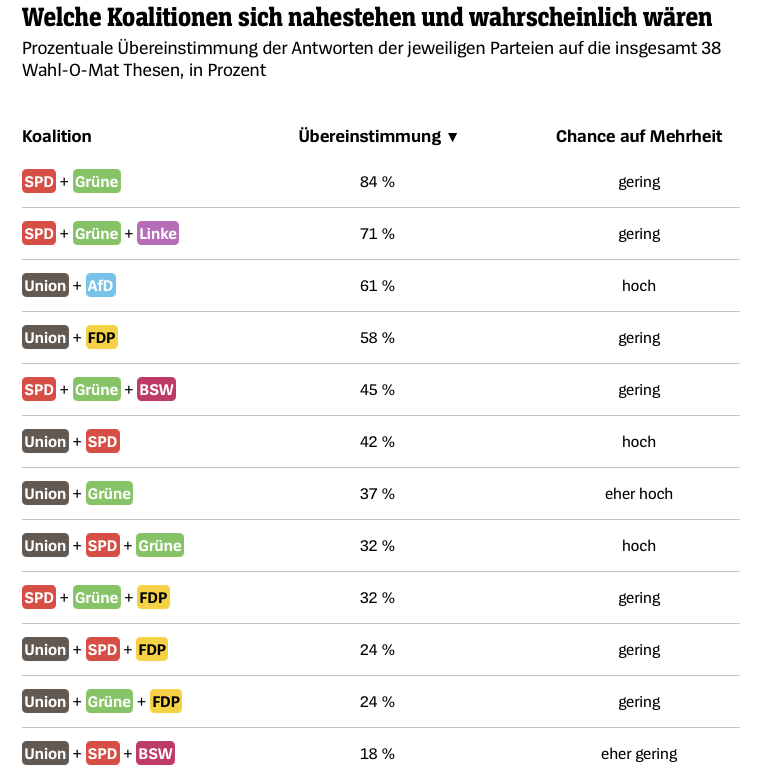
Der Spiegel attempted to predict the possible ruling coalitions after the country’s elections next week, based on percentage of agreement of policies and chances to reach a majority. Image: Der Spiegel
Germans will head to the polls for federal elections on February 23. Der Spiegel says that until then, it is difficult to predict what will happen next and who might form a coalition. As of now, there are no clear majorities on either the right or the left, but the differences between parties on both sides of the spectrum seem to be deepening, with immigration at the center of the debate. The team analyzed the similarities and differences between German parties, and what possible coalitions they might form using data from “Wahl-O-Mat” (“Vote-O-Mat”) — a question-and-answer tool that shows users which party is closest to their political position — and information contained in the parties’ party and election manifestos. Graphs show the percentage of agreement with the parties’ answers, the results of electoral surveys, and an analysis of hypothetical scenarios of the coalitions that could be formed and the probability of each one coming to fruition. According to Der Spiegel, some of these alliances would be unrealistic, while others, although seeming certain, are unlikely — because not all parties with similar policy positions would like to form a coalition. At the end of the piece, it is possible to check the 38 questions of the Wahl-O-Mat and the position of each of the seven parties.
Investigating the Russian Shadow Fleet
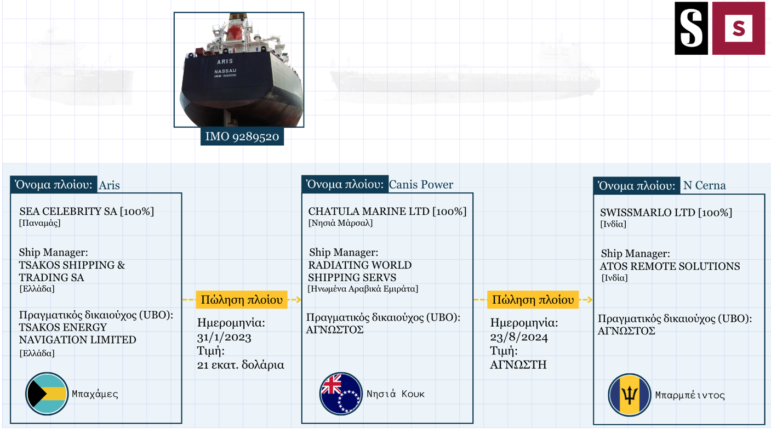
The Greek investigative outlet Solomon was part of a cross-border collaboration looking into Russia’s shadow fleet of oil tanks, tracking how one ship was repeatedly renamed and reflagged in recent years to avoid sanctions tracking. Image: Screenshot, Solomon
The database of the Ukrainian research institute, Kyiv School of Economics (KSE), was the starting point for the cross-border investigation Shadow Fleet Secrets, which involved 40 journalists from nine countries and uncovered how hundreds of old oil tankers are being used to evade sanctions on Russian oil trade. In this piece, the Greece-based nonprofit Solomon revealed that between 2022 and 2024, at least 230 tankers were sold by their legal European and US owners to other countries after Russia’s invasion of Ukraine in February 2022 and ended up — often after successive sales — as part of a shadow fleet that circumvents Western sanctions. Changing the name, flag, and ownership is a common way to obscure a ship’s past and confuse port authorities and insurers. The report included graphs showing the nationality of the vessels that ended up in the Russian shadow fleet — Greek shipowners are said to have sold 55% of these vessels, 127 of the 230 tankers investigated — and the revenue received by different countries from the sales of tankers to the Russian shadow fleet, with the Greeks leading once again. The investigation also included a timeline of events related to the sales of these vessels. The value of the transactions was calculated using data from the VesselsValue website.
The Race to Dominate the Arctic
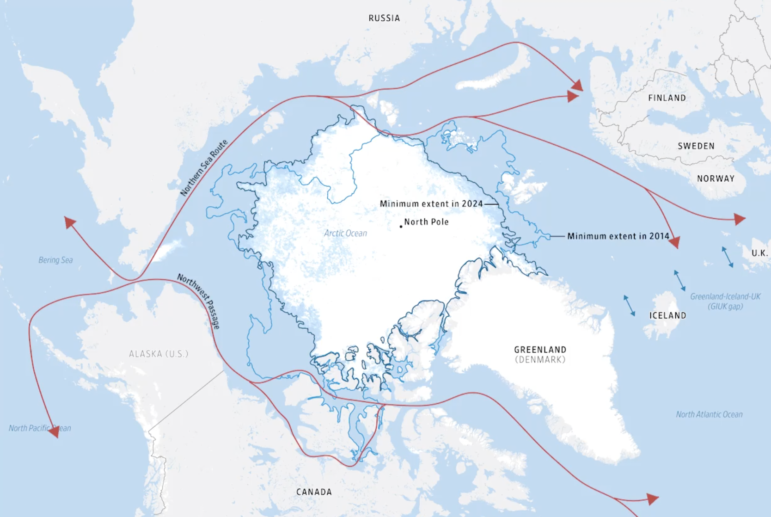
Mapping Arctic sea lanes newly open due to melting sea ice from climate change. Image: Screenshot, The Wall Street Journal
On the subject of ships and Russia, this special visual report from The Wall Street Journal showed how Moscow is increasing its presence in the globe’s far north, collaborating with China and leaving the US behind. With the region warming nearly four times faster than the rest of the planet in recent decades, the resulting lack of sea ice is opening up its waters to global shipping — and now, to military interests. According to the Journal, Russian military forces have conducted numerous military exercises in the region, as well as patrols, often in conjunction with the Chinese. Growing animosity between Russia and NATO has prompted both sides to renew military deployments in the region, the report says, as it offers prime territory for attack — there are only 85 kilometers (53 miles) between Russia and the US across the Bering Strait, near the Arctic Circle. President Trump recently put the region in the spotlight by repeatedly suggesting the US buy the self-governing territory of Greenland from Denmark to expand its presence in the Arctic. (The US already has an air force base and early warning radar installation on Greenland.) The report featured graphs on the minimum extent of sea ice in the Arctic and the number of transit voyages in the North Sea, and a series of maps on topics such as Arctic bases over time, maritime traffic, and possible mineral resources in the region.
Africa’s Critical Metals
Le Monde is running a seven-part special on the global race for “strategic” or “critical” metals, essential for the energy and digital transition, in the as-yet unexplored subsoil of Africa. According to the International Energy Agency (IEA), overall consumption of these minerals will quadruple by 2040. However, as the French newspaper explained, current global production is largely insufficient and the sum of mining projects planned by 2030 would be at least 10 times lower than the need. In addition, China is establishing dominance across the entire value chain, even operating mines abroad — and controlling around 30 of the 50 or so critical metals. Unlike the world’s main mining areas, where resources will soon be depleted, Africa is emerging as a vast unexplored terrain for the major powers: around one-third of the world’s reserves of all metals are found there. The newspaper featured a series of graphs on topics such as Africa’s share of global critical mineral reserves and the production of critical materials by country. As Le Monde explained, until now, major mining companies have tended to avoid Africa because they consider it high-risk due to several factors — such as high energy prices, the lack of infrastructure to transport production, and political instability.
Why Some Homes Survived the Los Angeles Fires
In January, a series of raging wildfires swept across Los Angeles killing at least 27 people and consuming more than 14,000 acres of homes and businesses. In the satellite images of the devastated neighborhoods, the damage seems immeasurable and it is difficult to notice that, amid piles of rubble and ash, a few buildings resisted the flames. In this special feature, The Washington Post showed that, whether by design or accident, some homes had structural advantages that helped them survive. They were built with noncombustible materials or had no vegetation around them — precisely to prepare for the threat of a wildfire. According to the Post, these homes are now the focus of experts looking for clues about how other homeowners can prepare for the future. The newspaper used one house as an example, visually showing and explaining all the unique features that made this house fire-resistant. The Post also featured images of damage to homes that appear to have survived by sheer luck, looked at two nearly identical adjacent homes built of similar materials, only one of which was destroyed, and provided a map assessing the building damage from the Eaton fire and a chart showing that most of the affected homes were built before the 1970s.
Indigenous Struggle Against Sexual Violence in Peru
In this special, El Comercio explored some of the social problems in the province of Condorcanqui, in the Peruvian Amazon, such as violence against women and teenage pregnancy, and showed how a group of women from the Awajún Indigenous people have been working to protect girls and educate communities with the support of members and leaders. According to the report, the number of pregnant girls and teenagers has increased five-fold in the past decade in the region. Through an interactive visualization, the team presented data on cases of sexual violence reported to the Women’s Assistance Centers (CEM), highlighting those committed against minors under 18 years of age, the number of complaints received by the Awajún Women’s Council, and the national figures for pregnant teenagers between the ages of 15 and 19. The Peruvian daily newspaper also provided background about the geography of the remote province — which often depends on river transport; as well as information about the population and its social situation.
Bonus: Is Your Password Secure?

ABC plotted the most popular — and therefore least secure — four-digit passwords. 1-2-3-4 is used by nearly one in 10 people. Image: Screenshot, ABC
A four-digit PIN can be used for many things: unlocking a smartphone, accessing a bank account, or withdrawing cash from an ATM. But how secure is yours? In this report, Australia’s ABC News showed that not all choices are equally secure — and that one in 10 people use the same four-digit PIN. They analyzed 29 million PINs from the Have I Been Pwned? website, which allows internet users to check whether their personal data has been compromised in data breaches. Be sure to check out the top 50 PINs to avoid!

